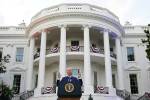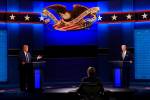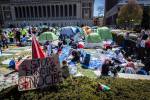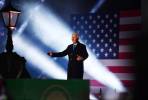New president sees pluses among minuses
Right now may be the worst time ever to take over as president of UNLV. Professors are job hunting, the last president was humiliated and dumped, and budget cuts have been so severe that entire programs face possible elimination.
And yet, Neal Smatresk volunteered for this job. And he's still smiling about it.
He took over earlier this month after serving in the administration for a little over two years. Smatresk said he's been busy providing "face time" to anybody interested in meeting with him.
But he also has been trying to figure out how to keep the doors open.
State support for the university is dropping, tuition is rising, grant money -- the lifeblood of a serious research university -- is stagnant at best. And with the economy in shambles, raising private money is no picnic.
Smatresk calls all that "really serious challenges."
But he refuses to be flustered. Ask him about cuts, he smiles and offers temporary fixes. Ask him about the future, he smiles and says the university has a plan. Ask him about a 9-foot-long fish that looks like a dinosaur, he smiles and goes on and on about the beauty of nature, the joy of learning, the passion of being a teacher.
"If you love what you do, you really want your students to learn it and understand it," he said. "And once you start down that road, I guess you keep looking on to the next place, and on up the road."
Smatresk is a biologist, specifically a zoologist who specialized in the respiratory systems of fish back when he was still teaching and doing science instead of riding an administrator's desk.
He came upon that specialty almost by accident when he learned about the gar fish. This thing is ugly, with a huge snout full of sharp teeth. But what made it interesting to the budding biologist was this: It has both lungs and gills.
Lungs and gills! In the same animal!
"They're living fossils," Smatresk said. "If you're a curious individual, that's a lot of fun."
And so Smatresk spent his career becoming an expert on fish breath. He pondered what all that means to humanity, what it means to the world. He became kind of famous in certain fish-expert circles.
Which makes him somewhat like his predecessor, David Ashley, a fairly renowned engineer who, among other things, helped rejigger the Panama Canal.
Also, neither man served as a university president before taking over at the University of Nevada, Las Vegas.
Beyond that, Ashley and Smatresk appear to have little in common.
Ashley was admittedly uncomfortable in public situations, a deficit for which he was roundly criticized, especially in the area of public relations and fundraising.
Smatresk, on the other hand, is chatty and jokey and does not seem at all uncomfortable, whether speaking to a roomful of people or one-on-one in an office.
He was UNLV's provost -- the university's No. 2 guy, the one who makes the trains run on time -- for a little over two years before the higher education system's Board of Regents named him president without seriously searching for a replacement. Smatresk had the full support of administrators, deans, students, professors, alumni, fundraisers and community big shots before taking over.
"We feel very confident in Neal's ability to guide us through this," said John Filler, chairman of the faculty senate.
Filler said times are tough at UNLV right now; he's worried about losing his colleagues. The state cut the university's budget by about 15 percent, and many expect more cuts could follow. There's a review process going on right now to figure out which programs to keep and which to eliminate. The committee doing the review faced a December deadline.
"Right now, we are hurting," Filler said.
So why did Smatresk want the job? Because he loves the idea of a university.
He came here in 2007 from the administration of the University of Hawaii at Manoa, which has about half the student population of UNLV but more than triple the federal grants.
Before that, Smatresk had spent 22 years at the University of Texas, Arlington as a student, a professor and an administrator.
The way there
He knows UNLV has a long way to go. But he said he sees the way there.
First, the immediate crisis. The cutting of programs, the trimming of fat, such as small classes and some activities, leaving open positions unfilled. But this will only work for a while, Smatresk said. Eventually, it will take its toll on faculty, staff and students.
If it continues, he said, the university will lose faculty, grants and its reputation.
If all that were to happen, the goal of becoming a major research university will be either dead or even further away than it is now.
"In the short run, we're going to make it," he said. "But if this (more cuts) happens in the next biennium, we're going to change this institution in irrevocable ways."
So, next up will be reworking the formula the state uses to fund its higher education institutions. UNLV has long complained that the setup is unfair, that the campus too often gets short shrift when it comes to state funding. There's a plan to fix that, and Smatresk and others insist they have momentum on their side. And they're not waiting for the next legislative session to get started.
"The time for that is now," Smatresk said. "The middle of a session is no place to get real work done."
After that comes expanding UNLV's research, a goal that every recent president of the university has had.
According to figures from its finance office, UNLV consistently brings in less than 20 percent of its annual revenue from federal grants. That's compared to an average of 37 percent of its revenue from state tax dollars over the last nine years, nearly a quarter from tuition and fees and 2-plus percent from gifts.
Compare those numbers to revenue for the University of Arizona, a university which UNLV often seems to aspire to emulate: 32 percent from grants, 18 percent from tuition, 28 percent from the state, and 4 percent from gifts.
Nationally, according to the U.S. Department of Education, public institutions get an average of 32 percent of their revenue from the state.
Gerry Bomotti, UNLV's senior vice president for finance and business, acknowledged that UNLV gets a high percentage of its revenue from the state, but he said that's because it's a young university that's still finding its footing.
Well-established schools get more private money -- they have more alumni -- and more research funding.
By getting more money from the state now, it will make UNLV better in the long run, the thinking goes.
Filler agreed, saying investing in up-and-coming areas now, such as renewable energy, could bring in loads of cash later on.
"We have a tremendous potential for leading the nation in terms of solar energy and renewable energy," said Filler, a professor of special education. "That's a ready-made opportunity for UNLV."
That is one of Smatresk's long-term goals. Like his predecessors, he touted what would be the benefits of having a major research university, namely high-paying jobs in expanding fields of science, engineering and health care.
But the lack of money from the state is holding the university back, he said. It is expensive to educate students in those fields.
"Every time I add a student in nursing, I have to take away three in liberal arts," he said.
It's also more expensive to educate a graduate student than it is an undergraduate, and research universities have tons of graduate students.
So, this is what's on his wish list: more money; the ability to not only keep tuition and fees (that currently goes to the state's general fund), but the ability to charge more for some high-cost programs, such as health care; higher tuition for out-of-state residents; and local support for the community colleges, which would remove some of the responsibility from UNLV to teach undergraduates.
Smatresk, still smiling, insisted all that is doable.
Contact reporter Richard Lake at rlake @reviewjournal.com or 702-383-0307.
Major sources of funding
UNLV
State appropriation: 37 percent
Tuition and fees: 23 percent
Grants and contracts: 19 percent
Gifts: 2.7 percent
National average for public institutions
State appropriation: 32 percent
Tuition and fees: 18 percent
Grants and contracts: 14 percent
Gifts: 5 percent
Sources: UNLV finance office, U.S. Department of Education



























